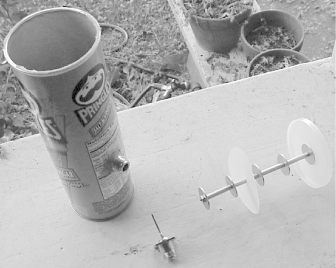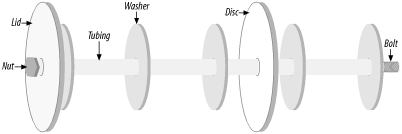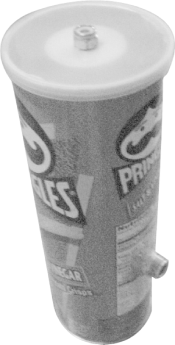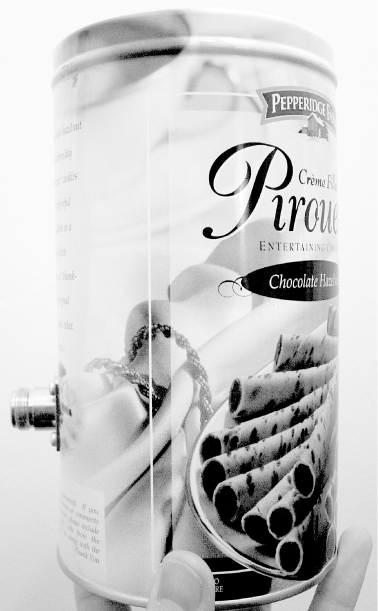7.4 Home-Brew Antennas
Since the first edition of this book was published, many new home-brew antenna designs that work at 2.4GHz have been published online (and more are being thought up every day). Here are just two ingenious examples.
7.4.1 The Pringles Can
At the Portland Summit in June 2001, Andrew Clapp (http://www.netscum.com/~clapp/) presented a novel yagi antenna design. It used a bolt, metal tubing, washers, and PVC tubing to make an inexpensive "shotgun" yagi, either 18" or 36" long. While his antenna shows between 12 and 15dBi gain (which is impressive for such a simple design), it's also quite large. When we returned from Portland, some members of our local group and I realized that, if we were careful, we could fit a full wavelength inside of a Pringles can as shown in Figure 7-1. This would show a reduced total gain, but it would also make the entire antenna much more compact.
Figure 7-1. The complete antenna (it's just a can!)

7.4.1.1 Parts list:
|
Part |
Approximate cost |
|---|---|
|
All-thread, 5 5/8" long, 1/8" OD |
$1.00 |
|
Two nylon lock nuts |
$0.10 |
|
Five 1" washers, 1/8" ID |
$0.10 |
|
6" aluminum tubing, 1/4" ID |
$0.75 |
|
A connector to match your radio pigtail(we used a female N connector) |
$3.00 |
|
1 1/2" piece of 12 gauge solid copper wire(we used ground wire from house electrical wiring) |
negligible |
|
A tall Pringles can(any flavor, Ridges are optional) |
$1.50 |
|
Scrap plastic disc, 3" across(like another Pringles can lid) |
negligible |
|
Total: |
$6.45 |
Of course, buying in bulk helps a lot. You probably won't be able to find a 6-inch piece of all-thread; buy the standard size (usually one or two feet) and a 10-pack of washers and nuts while you're at it. Then you'll have more than enough parts to make two, all for about $10.
7.4.1.2 Required tools
You'll need the following tools to make your antenna:
Ruler
Scissors
Pipe cutter (or hacksaw or dremel tool, in a pinch)
Heavy-duty cutters (or dremel again, to cut the all-thread)
Something sharp to pierce the plastic (an awl or a drill bit will work)
Hot glue gun (unless you have a screw-down type connector)
Soldering iron
Construction time should be about an hour.
7.4.1.3 Front collector construction
Mark and cut four pieces of tubing, about 1.2 inches (1 15/64 inches). Where did I get this number? First, figure out the wavelength at the bottom of the frequency range we're using (2.412GHz, or channel 1). This will be the longest that the pipe should be:
- W = 3.0 x 108 x (1 / 2.412) x 10-9
- W = (3.0 / 2.412) x 10-1
- W = 0.124 meters
- W = 4.88 inches
We'll be cutting the pipe to quarter wavelength, so:
- 1/4 W = 4.88 / 4
- 1/4 W = 1.22 inches
Now figure out what the shortest length we'll ever use is (2.462GHz, or channel 11 in the United States):
- W = 3.0 x 108 x (1 / 2.462) x 10-9
- W = (3.0 / 2.462) x 10-1
- W = 0.122 meters
- W = 4.80 inches
- 1/4 W = 1.20 inches
Practically speaking, what's the difference between the shortest pipe and the longest pipe length? About 0.02 inches, or less than 1/32 of an inch. That's probably about the size of the pipe cutter blade you're using. So, just shoot for 1.2 inches, and you'll get it close enough.
Cut the all-thread to exactly 5 5/8 inches. The washers we used are about 1/16 of an inch thick, so that should leave just enough room for the pipe, washers, and nuts.
Pierce a hole in the center of the Pringles can lid big enough for the all-thread to pass through. Now is probably a good time to start eating Pringles (we found it better for all concerned to just toss the things; salt and vinegar-flavored Pringles are almost caustic after the first fifteen or so. Heed the recommended serving size!).
Cut a 3-inch plastic disc just big enough to fit snugly inside the can. We found that another Pringles lid, with the outer ridge trimmed off, works just fine. Poke a hole in the center of it, and slip it over one of the lengths of pipe.
Now, assemble the pipe. You might have to use a file or dremel tool to shave the tips of the thread if you have trouble getting the nuts on. The pipe is a sandwich that goes on the all-thread as shown in Figure 7-2.
Figure 7-2. Nut, lid, washer, pipe, washer, pipe, washer, pipe-with-plastic, washer, pipe, washer, nut

Tighten down the nuts to be snug, but don't overtighten (I bent the tubing on our first try; aluminum bends very easily). Just get it snug. Congratulations, you now you have a front collector just like the one shown in Figure 7-2.
7.4.1.4 Preparing the can
By now you should have eaten (or tossed) the actual chips. Wipe out the can, and measure 3 3/8 inchesup from the bottom of the can. Cut a hole just big enough for the connector to pass through. We found through trial and error that this seems to be the "sweet spot" of the can. On our Pringles Salt & Vinegar can, the N connector sat directly between "Sodium" and "Protein."
7.4.1.5 Element construction
Straighten the heavy copper wire and solder it to the connector. When inside the can, the wire should be just below the midpoint of the can (ours turned out to be about 1 1/16 inches). You lose a few dB by going longer, so cut it just shy of the middle of the can.
We were in a hurry, so we used hot glue to hold the connector in place on our first antenna. If you have a connector that uses a nut and washer, and you're really careful about cutting the hole, these work very well (and aren't nearly as messy as hot glue). Just remember that you're screwing into cardboard when you connect your pigtail. It's very easy to forget and accidentally tear the wall of the can.
Now, insert the collector assembly into the can and close the lid. The inside end of the pipe should not touch the copper element; it should be just forward of it. If it touches, your all-thread is probably too long. Figure 7-3 shows a completed antenna.
Figure 7-3. The completed antenna

How can you estimate gain without access to high-end radio analysis gear? Use the Link Test software that comes with the Orinoco silver cards to read the signal and noise readings (in dB) at both ends of a connection. As I happen to live six-tenths of a mile (with clean line of sight) from O'Reilly headquarters, we had a fairly controlled testbed to experiment with. We shot at the omni on the roof and used the access point at O'Reilly as our link test partner.
To estimate antenna performance, we started by connecting commercial antennas of known gain and taking readings. Then we connected our test antennas and compared the results. We had the following at our disposal:
Two 10dBi, 180-degree sector panel antennas
One 11dBi, 120-degree sector panel antenna
One 24dBi parabolic dish
A couple of Pringles cans and some hardware
Here were the average received signal and noise readings from each, in approximately the same physical position:
|
Antenna |
Signal |
Noise |
|---|---|---|
|
10dBi A |
-83db |
-92db |
|
10dBi B |
-83db |
-92db |
|
11dBi |
-82db |
-95db |
|
24dBi |
-67db |
-102db |
|
Pringles can |
-81db |
-98db |
The test partner (AP side) signal results were virtually the same. Interestingly, even at only six-tenths of a mile, we saw some thermal fade effect; as the evening turned into night, we saw about 3db gain across the board. (It had been a particularly hot day: almost 100 degrees. I don't know what the relative humidity was, but it felt fairly dry.)
Yagis and dishes are much more directional than sectors and omnis. This bore out in the numbers, as the perceived noise level was consistently lower with the more directional antennas. This can help a lot on long-distance shots; not only will your perceived signal be greater, the competing noise will seem to be less. More directional antennas also help keep noise down for any neighbors who might be trying to share the spectrum. Be a good neighbor and use the most directional antennas that will work for your application (yes, noise is everybody's problem).
The Pringles can seemed to have large side lobes that extend about 45 degrees from the center of the can. Don't point the can directly at where you're trying to go; aim slightly to the left or the right. We also found that elevating the antenna helped a bit. When aiming the antenna, hold it behind the connector, and slowly sweep from left to right, with the Link Test program running. When you get the maximum signal, slowly raise the end of the can to see if it makes a difference. Go slowly, changing only one variable at a time.
Remember that the can is polarized, so match the phase of the antenna you're talking to. For example, if shooting at an omni, be sure the element is on the bottom or the top of the can, or you won't be able to see it! See the earlier discussion on antenna polarization for how you can use this effect to your advantage.
We were fortunate enough to have a member of our community group bring a return loss meter to one of our meetings, and we were able to get some actual measurements of how much signal was returning to the radio. The results weren't as good as I had hoped, but they showed that the antenna was usable, particularly at lower frequencies. Most likely, failing to take into account the thickness of the washers has made the entire front element a little too long. There isn't nearly enough power leaving the radio to cause damage due to high return loss, but it does point out that the antenna isn't as well tuned as it could be.
7.4.2 Stew and Cookie Cans
Since the Pringles can story was published, I have received a phenomenal amount of email from people who have tried it for themselves. While some people simply enjoyed making a recycled antenna out of a piece of trash, many others wrote to say, "You know, that's not a bad design, but some friends and I found a better way to do it . . . " One such person was Gregory Rehm. He took my Pringles can design and another coffee can design that I was working on, and pitted them against his own designs (including a 40-ounce stew can) in a Wireless Shootout Battle Royale. His experimentation and excellent analysis is documented on his web site at http://www.turnpoint.net/wireless/has.html.It is very entertaining to read, but in case you're too filled with suspense to operate a browser: his stew can won by a mile.
As it turns out, it is much simpler to make a tin can waveguide antenna than to bother with cutting pipe and spacing washers apart on all-thread. Gregory has an excellent how-to (complete with photos, diagrams, and formulae) online at http://www.turnpoint.net/wireless/cantennahowto.html.
Another common can that approaches the ideal size for 2.4GHz is the Pepperidge Farm Pirouette can (see Figure 7-4). It makes a much simpler, sturdier, and more efficient antenna than a Pringles can, and you get to eat the cookies!
Figure 7-4. The Pirouette cantenna

There are a number of variations on the basic waveguide antenna floating around the Internet, involving such wacky ideas as modified DSS dishes and sardine cans. Look at any of the major wireless community sites for a variety of antenna designs, including omnis, yagis, waveguides, and much more.






